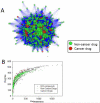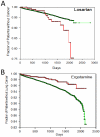Exploring a structural protein-drug interactome for new therapeutics in lung cancer
- PMID: 24402119
- PMCID: PMC4016822
- DOI: 10.1039/c3mb70503j
Exploring a structural protein-drug interactome for new therapeutics in lung cancer
Abstract
The pharmacology of drugs is often defined by more than one protein target. This property can be exploited to use approved drugs to uncover new targets and signaling pathways in cancer. Towards enabling a rational approach to uncover new targets, we expand a structural protein-ligand interactome () by scoring the interaction among 1000 FDA-approved drugs docked to 2500 pockets on protein structures of the human genome. This afforded a drug-target network whose properties compared favorably with previous networks constructed using experimental data. Among drugs with the highest degree and betweenness two are cancer drugs and one is currently used for treatment of lung cancer. Comparison of predicted cancer and non-cancer targets reveals that the most cancer-specific compounds were also the most selective compounds. Analysis of compound flexibility, hydrophobicity, and size showed that the most selective compounds were low molecular weight fragment-like heterocycles. We use a previously-developed screening approach using the cancer drug erlotinib as a template to screen other approved drugs that mimic its properties. Among the top 12 ranking candidates, four are cancer drugs, two of them kinase inhibitors (like erlotinib). Cellular studies using non-small cell lung cancer (NSCLC) cells revealed that several drugs inhibited lung cancer cell proliferation. We mined patient records at the Regenstrief Medical Record System to explore the possible association of exposure to three of these drugs with occurrence of lung cancer. Preliminary in vivo studies using the non-small cell lung cancer (NCLSC) xenograft model showed that losartan- and astemizole-treated mice had tumors that weighed 50 (p < 0.01) and 15 (p < 0.01) percent less than the treated controls. These results set the stage for further exploration of these drugs and to uncover new drugs for lung cancer therapy.
Figures





References
-
- Lee W, Jiang Z, Liu J, Haverty PM, Guan Y, Stinson J, Yue P, Zhang Y, Pant KP, Bhatt D, Ha C, Johnson S, Kennemer MI, Mohan S, Nazarenko I, Watanabe C, Sparks AB, Shames DS, Gentleman R, de Sauvage FJ, Stern H, Pandita A, Ballinger DG, Drmanac R, Modrusan Z, Seshagiri S, Zhang Z. Nature. 2010;465:473–477. - PubMed
-
- Jones S, Zhang X, Parsons DW, Lin JC, Leary RJ, Angenendt P, Mankoo P, Carter H, Kamiyama H, Jimeno A, Hong SM, Fu B, Lin MT, Calhoun ES, Kamiyama M, Walter K, Nikolskaya T, Nikolsky Y, Hartigan J, Smith DR, Hidalgo M, Leach SD, Klein AP, Jaffee EM, Goggins M, Maitra A, Iacobuzio-Donahue C, Eshleman JR, Kern SE, Hruban RH, Karchin R, Papadopoulos N, Parmigiani G, Vogelstein B, Velculescu VE, Kinzler KW. Science. 2008;321:1801–1806. - PMC - PubMed
-
- Sjoblom T, Jones S, Wood LD, Parsons DW, Lin J, Barber TD, Mandelker D, Leary RJ, Ptak J, Silliman N, Szabo S, Buckhaults P, Farrell C, Meeh P, Markowitz SD, Willis J, Dawson D, Willson JK, Gazdar AF, Hartigan J, Wu L, Liu C, Parmigiani G, Park BH, Bachman KE, Papadopoulos N, Vogelstein B, Kinzler KW, Velculescu VE. Science. 2006;314:268–274. - PubMed
-
- Parsons DW, Jones S, Zhang X, Lin JC, Leary RJ, Angenendt P, Mankoo P, Carter H, Siu IM, Gallia GL, Olivi A, McLendon R, Rasheed BA, Keir S, Nikolskaya T, Nikolsky Y, Busam DA, Tekleab H, Diaz LA, Jr., Hartigan J, Smith DR, Strausberg RL, Marie SK, Shinjo SM, Yan H, Riggins GJ, Bigner DD, Karchin R, Papadopoulos N, Parmigiani G, Vogelstein B, Velculescu VE, Kinzler KW. Science. 2008;321:1807–1812. - PMC - PubMed
-
- Wood LD, Parsons DW, Jones S, Lin J, Sjoblom T, Leary RJ, Shen D, Boca SM, Barber T, Ptak J, Silliman N, Szabo S, Dezso Z, Ustyanksky V, Nikolskaya T, Nikolsky Y, Karchin R, Wilson PA, Kaminker JS, Zhang Z, Croshaw R, Willis J, Dawson D, Shipitsin M, Willson JK, Sukumar S, Polyak K, Park BH, Pethiyagoda CL, Pant PV, Ballinger DG, Sparks AB, Hartigan J, Smith DR, Suh E, Papadopoulos N, Buckhaults P, Markowitz SD, Parmigiani G, Kinzler KW, Velculescu VE, Vogelstein B. Science. 2007;318:1108–1113. - PubMed
Publication types
MeSH terms
Substances
Grants and funding
LinkOut - more resources
Full Text Sources
Other Literature Sources
Medical

